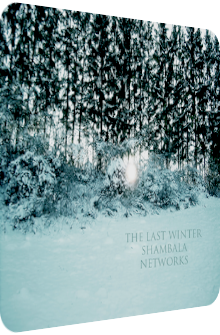
Shambala Networks
The Last Winter
2010
It‘s the middle of March right now, and one of the last opportunities to present frosty, vespertine albums for Winter. While the police takes no action if you‘re listening to a glacial album in summertime and even though this review can be accessed 365 days a year anyway, it feels just right to review certain albums at certain times. Shambala Networks‘ The Last Winter of 2010 is such an album, although it is not what it seems to be at first glance; more about this in a few seconds. Shambala Networks is the one-man Ambient project of Oliver Dombi from Romania, and as is the case with everything Ambient I come across, it drums up my interest, even more so when Dombi himself describes The Last Winter on his Bandcamp website as an album that depicts a »semi-dark ambient world,« and as such is able to lay open the nuances, shades, overtones and respective counterbalances in its setting. In contrast to the Norse duo Pjusk and their similarly themed album Tele of 2012 or Yagya‘s Icelandic Deep House-Ambient hybrid Rhythm Of Snow of 2002, the subject matter moves into more psychedelic and straggly realms: the journey doesn‘t take place in a hibernal landscape, but is happening in a transcendental fashion, allowing the fictitious listener to travel through time and space as The Last Winter suggests with title fragments such as galaxies and dark matter. Listening to the album from this perspective suddenly unveils a second, completely different meaning that should please fans of darkly warped Sci-Fi synth anthems and post-apocalyptic wastelands. In fact, I very much prefer the second meaning of a spiritual, disembodied journey that can be completely detached from the depicted scenery on the front artwork. The gloomily droning and soothingly majestic synthscapes are much better in evoking a space setting than a lost, winterly world. However you may interpret the true core of the album, let‘s dive into the majority of its tracks first before drawing the final conclusion.
Atszellemulve (Spiral Galactic Core) is the gateway to a dark but comfortably mellow world. Quavering drones and enigmatic synth choirs are in constant interplay with warbled radio frequencies, chippers and splutters. This spheric piece is based on another common set of elements, namely the melange of upswelling and downfalling synth washes and the resulting concept of spaces and floating areas. This song marks a strong beginning, if only for the feeling that everything passes by while the listener is in that referenced core. The 15+ minute long Eso. Evszazad. Tenger (meaning Rain. Century. Sea) picks up the thread of Atszellemulve and starts with a dark drone, sumptuously ecclesial synth strings, echoey, cavernous rain droplets and metallic sounds. The rain sounds increase, and the calmness of the sustained tones is definitely appeasing, as are the whale song-like synth pulses in the last third. And that‘s basically my description for the whole song. It leaves a huge impact on the album, though! The distinct quality of Eso. Evszazad. Tenger is found in its runtime and Dombi‘s careful setup of introducing each element while retaining the aura, for there is always a risk of overloading a tune with too many motifs and elements, but this doesn‘t happen here. Although the song is rather minimal, the synths are vibrant and the accompanying rain drops are lush. Fiatal Galaxishalmaz (Young Galaxies) completes Dombi‘s galactic triptychon with spectral and definitely more eerie synth sculptures and occasional coruscating flitterings, voluminous bass pulses and effervescent sparkles. This is definitely my favorite track of the album, and while it floats seamlessly into the preceding track, the uncanniness coupled with the wideness are qualities that work particularly well in this regard. Top notch! The 12+ minute piece Lebeges (meaning Levitation) is next and pushes the eeriness even further. Incisive synth screeches are fragmented remainders of the Dark Ambient nature of this release, but the soothing strings in the background form the counterfactual parts and are at the same time the evidence for Dombi‘s depiction of a semi-dark world. Another killer track of the album‘s first half is called Internet, and its signature element consists of the multilayered, slightly cacophonous and rather tense synth strings that start blatantly clear but are blurred down to heater room-like drones and the curious addition of chirping birds, all the while the menacing drone remains in the background.
The second half of The Last Winter presents a slightly more varied pastiche and loosens the space theme in favor of a more crystalline and resplendent style. Skmp is breaking the boundaries and shifts the endemic style into something entirely different. The whole song consists of nothing more than a melody played on synth marimbas and bells with respective backings. It cannot get any more minimal than this, and all the former space elements are forgotten on this short interlude. What Life Was Meant To Be brings back the lush strings, bird noises and dark synth lines, but is otherwise much more melancholic. In its middle, the voluminous strings are reduced and uncover a fragile glistening string. The disaccord is boldly mentioned in the track title, and even though both the fragility and the mesmeric synths as well as the birds seem to add a feeling of lightness to the track, I believe that the opposite is the case: while the spacey tracks are darker and droning, their moods cannot be pinpointed easily. The feeling of floating complacently in space is thus better achieved in the darker pieces of The Last Winter – quite a contradiction, isn‘t it? Anyway, next is World Made Of Dark Matter, and it is yet another galactic song for dark drone fans. It paints a ghostlike setting with a terrifically frightening two-note scheme that breaks the monotony of the dark drones – it‘s similar to the theme of Jaws, but much slower and more pompous. The end of this scary piece contains various sustained one-note strings that are pitched differently. This is the most monotonous and dark song, and while it is quite scary, it never actually threatens or shocks the listener with effects, but remains in a sedate contemplation. Another great track with a cinematic setting. Idegrendszer (nervous system) is the complemental song to World Made Of Dark Matter, as it presents several monotonous drones as well, but here the drones are foggy and quavering. Sustained frizzles echo through the track and the claustrophobia increases due to the addition of creepy textures. Idegrendszer is as bright as the preceding track is dark, but the brightness doesn‘t transport sunlight or happy moments, but is again completely introverted and only shaped by synths that are pitched higher. Viragvege is the final piece and the most desponded one with echoey rain drops, distant eschatological synths that grow larger and unveil a rapturous superstructure of peace, calmness, but also inherits artifacts of anger and loneliness. The stern pulses that fly by as well as the fragments of warped voices and guitar pluckings are of particular interest. Dombi constructs an aural wasteland that is much more earthen than the beginning of The Last Winter. While I wouldn‘t call the album melancholic as a whole, this last song is truly a heavy ending for an otherwise spacious and transcendental journey.
The Last Winter provides the perfect foil for planetariums, videos of whirling bacteria under a scanning electron microscope, soundwall installations in museums of natural history and Science Fiction novellas. The list could go on endlessly. Strangely enough, the front artwork, while beautiful in itself, doesn‘t coincide or coalesce with the music at all, and this is especially true for the first half of the album which induces a gorgeous vista of planets in time and space. What is so particularly great about Shambala Networks‘ The Last Winter is the wide openness and the space it evokes. It is the perfect ethereal music which is not overly thick and tiresome, but oscillates skillfully between different expanses, textures and surfaces. If you embrace the ethereal heaviness of Shambala Networks‘ music, similarly themed albums are right at hand, for instance Jonson‘s Mindlook if you favor the aquatic tranquility, K8ema by Gel-Sol if you prefer spacier sounds with interwoven brightness and weird vocal samples, or take a look at Tony Scott‘s astral synthesis of Jazz and Ambient elements in his Voyage Into A Black Hole. I can recommend each of these three albums wholeheartedly as well, as their themes and settings are very similar. The second half of The Last Winter is a bit more varied, and music-related variety always brings the danger of irrelevant or anticlimatic songs along with it. Such being the case, Dombi succeeds in circumventing my fears with the stellar drone duo World Made Of Dark Matter and Idegrendszer that oscillates between the darkest worlds and the foggiest innards of living entities, but also bears out the stark modification of the atmosphere that was built in the first 6 songs. Further nitpicking aside, this is an unexpectedly majestic space album. Don‘t be put off by the front cover – as wonderful as it is, the music has next to nothing to do with it from my viewpoint. Apart from this minor quibble, The Last Winter is recommended for space travelers and Science Fiction fans who like their Ambient music dark, spheric and wide. Shambala Networks delivers a pleasant surprise for sure!
Ambient Review 047: Shambala Networks – The Last Winter (2010). Originally published on Mar. 14, 2012 at AmbientExotica.com.
